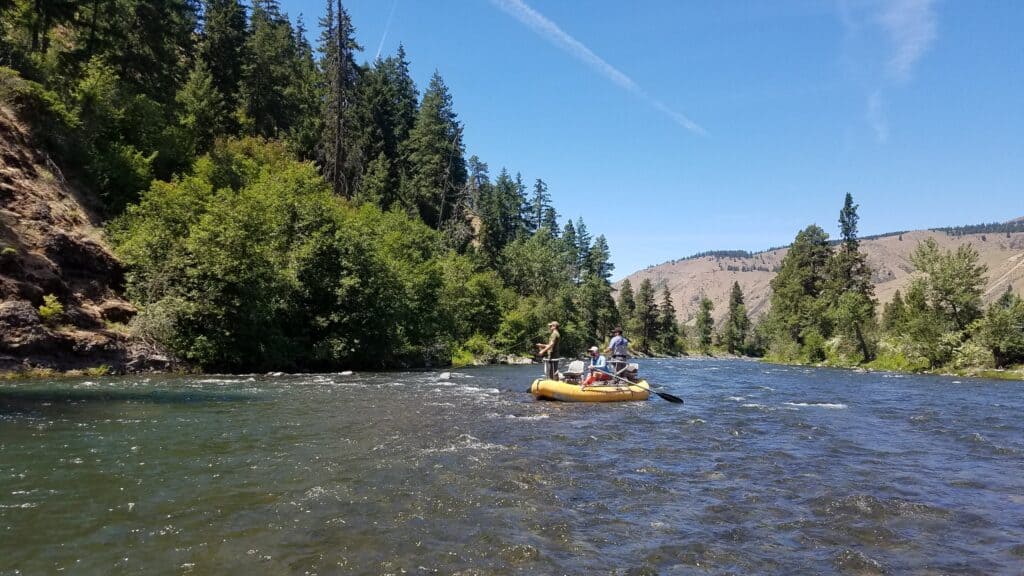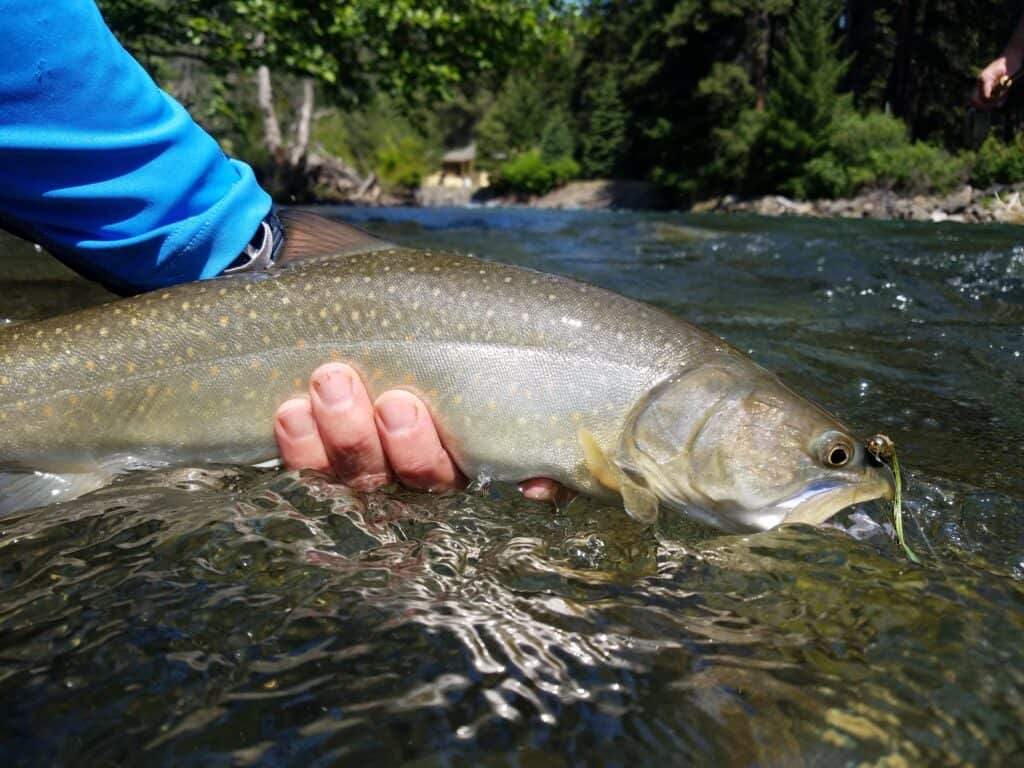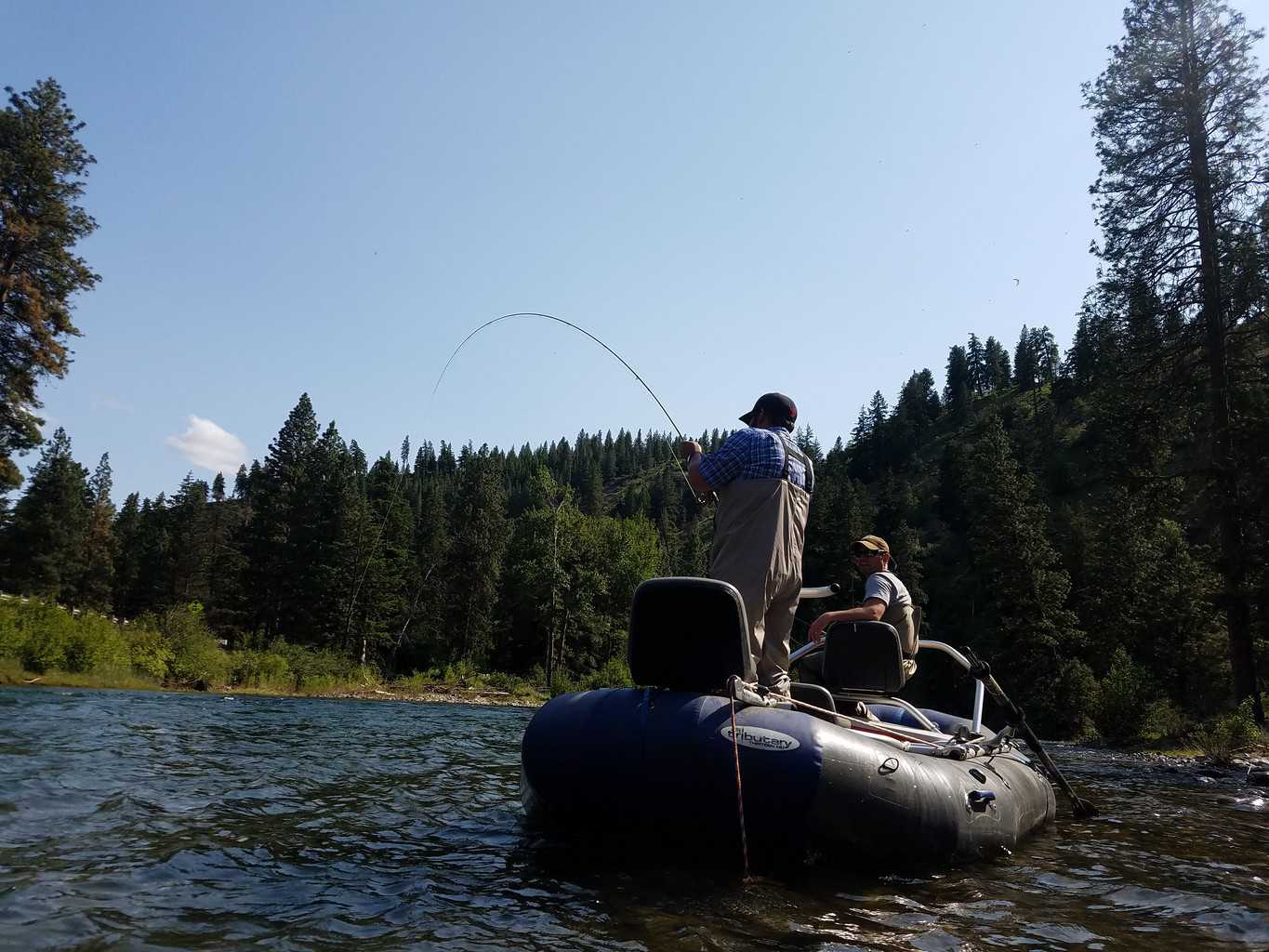If it were almost anywhere else, the Naches River and its major tributaries would get a lot more fishing attention than they do.
But tucked away in the Central Washington foothills and overshadowed by the famous Yakima River, the Naches River flies under the radar as a fun, productive trout stream.
The mainstem Naches River offers some of the best chances at catching a big westslope cutthroat trout in the Pacific Northwest, it also has several other types of trout and whitefish, and it’s a great option during the hot summer months.
For the reasons you’re going to read about, the Naches River is one of the Best Fly Fishing Rivers in Washington.
This article provides detailed information on the mainstem Naches, including the best fly patterns and seasonal approaches.
The article also discusses fishing in the four major tributaries that join to form the Naches: The Tieton, Little Naches, Bumping, and American rivers.
Most of those mountain streams have willing trout, and techniques used in the mainstem should work well in the tributaries as well.
Be sure to read the Washington Department of Fish and Wildlife’s general regulations and specific stream listings carefully for whichever places you fish, as there are a few differences depending on area and season both on the mainstem Naches River and its tributaries.
Trout Fishing

Trout fishing on the Naches can feel like a refreshing break from many of the other rivers in the Pacific Northwest: It’s straight-forward, there are plenty of eager fish, and there usually aren’t too many other fly fishermen around.
On the Naches, you’re able to focus on catching fish without having to get too technical, which can be perfect depending on what kind of fly fisherman you are.
The westslope cutthroat in the river can be caught on a variety of methods: streamers, dry flies, terrestrials and nymphs are great options.
If you’re wanting to fill your fly box with patterns for the Naches, remember that this is a freestone stream.
Perdigons, pheasant tails, frenchies and hare’s ear patterns all work extremely well. Parachute Adams and stimulators are great dry-fly patterns to have on hand.
If you’re fishing the river later in the summer, keep some big terrestrial patterns in your fly box – the Naches isn’t swarming with ants and grasshoppers, but you’ll still be able to rise a fish to terrestrial patterns during the warmer days of the year.
Stoneflies, mayflies and caddis hatch throughout the summer as well.
Remember that your hooks must be barbless.
Most fish in the river are between 12 and 16 inches, though there are exceptions on both sides.
While the river has special appeal for fly fishing, the Naches River falls under selective gear regulations, so you also can use lures such as spinners and spoons as long as they also have single-point, barbless hooks.
Rooster Tails and other spinners, with their treble hooks replaced with legal hooks, can be very good for cutthroat and rainbow trout.
There is a modest bag limit for a couple larger trout on part of the Naches, below the Tieton confluence, but most anglers approach this system as a catch-and-release experience for wild cutthroat and rainbow trout.
Bull trout of any size must be released unharmed, but if you find a brook trout or two (more common in the upper tributaries), you can keep them as long as you’re sure you can distinguish them from the bulls.
Mountain whitefish also can be harvested and are common in the Naches system.
Salmon and steelhead are protected throughout the Naches River and its tributaries.
Some of these big fish, including giant spring Chinook salmon during the trout season, do finish their spawning runs in the system.
So be mindful and leave anadromous fish and their spawning areas alone if you come across them while fishing for their smaller resident cousins.
Don’t come to the Naches expecting to catch trophy fish.
It’s true that the nearby Yakima does typically produce bigger fish, but it’s also much less accessible for bank fishermen and receives much more fishing pressure.
When to Fish
The Naches River is generally open from Memorial Day weekend through the end of October, but fishing picks up in July, once the water levels have stabilized. In June, the river can run high from snowmelt and other runoff.
As summer wears on, try putting on some terrestrial patterns to tempt the trout. When the cooler fall months approach, nymphing is usually the name of the game.
If you’re interested in floating the river, be cautious – when it’s high enough (usually in June), it can be extremely fast-moving and rapid, so it’s more of a whitewater rafting experience than a casual river float.
Also, more water is released for late-season irrigation downriver, usually starting around September, so fishing can get tough again in the main river below the Tieton.
Whitefish
Mountain whitefish are common in the Naches River and its tributaries.
While some trout purists scoff at this trout cousins, they are fun to catch and Washington allows anglers to keep a good number of them during trout season.
Fly anglers focus on sinking patterns fished close to the bottom in softer water if you want to catch whitefish, although they are mostly ignored when trout fishing is allowed.
The mainstem Naches below the Tieton River confluence only also has a special winter season for whitefish (and ONLY whitefish) during the months of December through February.
The upper river and tributaries also have whitefish but don’t currently allow wintertime fishing.
During this three-month span only, anglers can fish for these fun little fighters using either bait or artificial flies and lures, but only with small hooks (size 14 or smaller).
It can be a fun diversion to keep those fishing skills from getting rusty during breaks in the winter weather, when a lot of streams are closed to fishing.
Whitefish tend to school up in areas with less currents, so target the pools in this area and keep moving until you find a group.
If you’re going with flies, nymphs are a great option. Caddis, stonefly, midges and similar patterns are the ticket here.
If you’re going to dunk some bait, which is the easy way to catch whitefish where allowed, use a small piece of worm, a single salmon egg or a maggot on your small hook.
Whitefish are likely to be down near the bottom of these deeper sections, so whether fishing with flies or bait, you might need a pinch of weight to get down to them. If you’re bouncing occasionally off the bottom, that should do the trick.
Again, if you happen to catch a trout or any other fish, it must be released unharmed.
Whitefish are considered a delicacy in some regions but somewhat ignored as table fare in the Pacific Northwest.
While they are often similar in length to pan-sized rainbows, they are bony buggers.
Many anglers get the most from their whitefish catches by filleting and canning them, which softens the small bones and makes them a non-factor. Or whitefish are great smoked, when you can easily separate the meat from the bones.
Major Tributaries of the Naches River

Tieton River
The mainstem Tieton River flows out of Rimrock Reservoir and is closely followed by U.S. 12, a major route across Washington.
The highway follows the Tieton down to the river’s confluence with the Naches River that also is near U.S. 12’s intersection with State Route 410, which follows the Naches River upstream.
Given such easy access from a major route, the mainstem Tieton has its share of fishing pressure for smallish wild rainbow and cutthroat trout, plus there are protected bull trout in the system.
Long ago, prior to protection, in 1961 the Tieton produced the state record bull trout of 22.5 pounds.
The Tieton had been one of the area’s streams stocked with hatchery rainbow trout but no longer appears on WDFW’s stocking schedule, but you can fish for the other non-bull trout under typical state rules during the season.
Note that there are selective gear rules on the Tieton system, so you’ll be using barbless, single-point hooks on your flies and lures, and no bait.
There also can be good numbers of mountain whitefish in the river, which can be kept during trout season.
The North Fork Tieton above Clear Lake and its tributaries also are open seasonally for fishing, although there’s a closure to note near the Clear Lake Dam and a mid-August closure to all fishing.
It’s followed by U.S. Forest Service roads and provides a small trout stream experience that may appeal to some fly fishers.
Little Naches River
The Little Naches and Bumping rivers come together to form the main Naches River just north of Sawmill Flat Campground. On a map you’ll see SR 410 take a sharp turn at the confluence.
This is a fair trout stream but gets a fair amount of pressure because it’s very accessible along good Forest Service Roads and near a bunch of camping.
What you’ll mostly catch in the Little Naches and its little tributary creeks are smallish wild rainbow and cutthroat trout that should respond to flies and small spinners that follow selective gear rules.
These days the stream is not stocked with hatchery trout.
Be prepared for a momentary heart stop later in the season, when giant spring Chinook salmon show up to spawn. But don’t get too excited: You may under no circumstances fish for salmon here.
Bumping River
As with other streams in this region, the Bumping River has a ton of access and camping, so there’s a fair bit of fishing pressure for wild trout, which includes native rainbows and cutthroat and some non-native brook trout.
There is no limit on the brookies, but make sure you really can identify your trout because some people mistake them for less-colorful bull trout, which must be released unharmed.
Whitefish are another harvest option, if you like these tasty but bony fish.
The river below Bumping Lake (a reservoir) down to the confluence is accessible via Bumping River Road and a stretch of SR 410. It is subject to selective gear rules.
American River
This is a super-clear mountain stream that hosts wild native cutthroat and rainbow trout, along with non-native brook trout.
There also may be some bull trout, and you must always release these quickly and unharmed if caught incidentally.
You also might find some whitefish here as with elsewhere in the Naches River system.
The American enters the Bumping River near the American Forks Campground, just a few miles up from the Bumping’s confluence with the Little Naches.
Like some of the other streams in this area, the American River has spawning grounds for spring Chinook salmon later in the summer. These salmon must be left entirely alone to do their thing.
In fact, the American River has about a 10-mile section above the SR 410 bridge that’s closed to all fishing from mid-July to mid-September, which areas below and above this stretch follow a more traditional season.
Check the regulations extra careful before fishing, so you know where it’s legal.
Location and Access
The Naches River is located northwest of the town of Yakima, about 150 miles from Seattle.
U.S. 12 and Highway 410 follows the Naches River upstream from its confluence with the Yakima, and there are a variety of access points off of these roads that are productive.
The river is fairly long, and if you can manage to find access in the upper stretches, you’re almost certain to find solitude as well.
There are an incredible number of U.S. Forest Service campgrounds along the Naches River and its main tributaries, as well as overnight accommodations and supplies in the Yakima area.
If fishing isn’t going as planned on the Naches, don’t worry – the Yakima River is nearby, which can be a great backup plan if you get skunked. It’s true that the Yakima is best fished from a boat, but there are some great bank access points as well.
Rocky Ford Creek is about two hours to the northeast. It’s not close, but if you’re making a weekend trip and don’t find much luck on the Naches, it’s worth considering the extra couple of hours behind the wheel for the Rocky Ford experience.
The Naches River is one of Washington’s most underrated trout streams. Plentiful trout, the potential for big fish, and productive hatches throughout the summer make this a great fishery for a sunny day.
Find more fishing spots in Yakima County
Washington Resources
WDFW Fishing and Stocking Reports
WDFW Fishing Regulations
National Weather Service forecasts
Carter Reschke is a freelance writer based in Oregon. Passionate about the outdoors, Carter is a fly fishing aficionado and spends his days on the river when he’s not writing.

